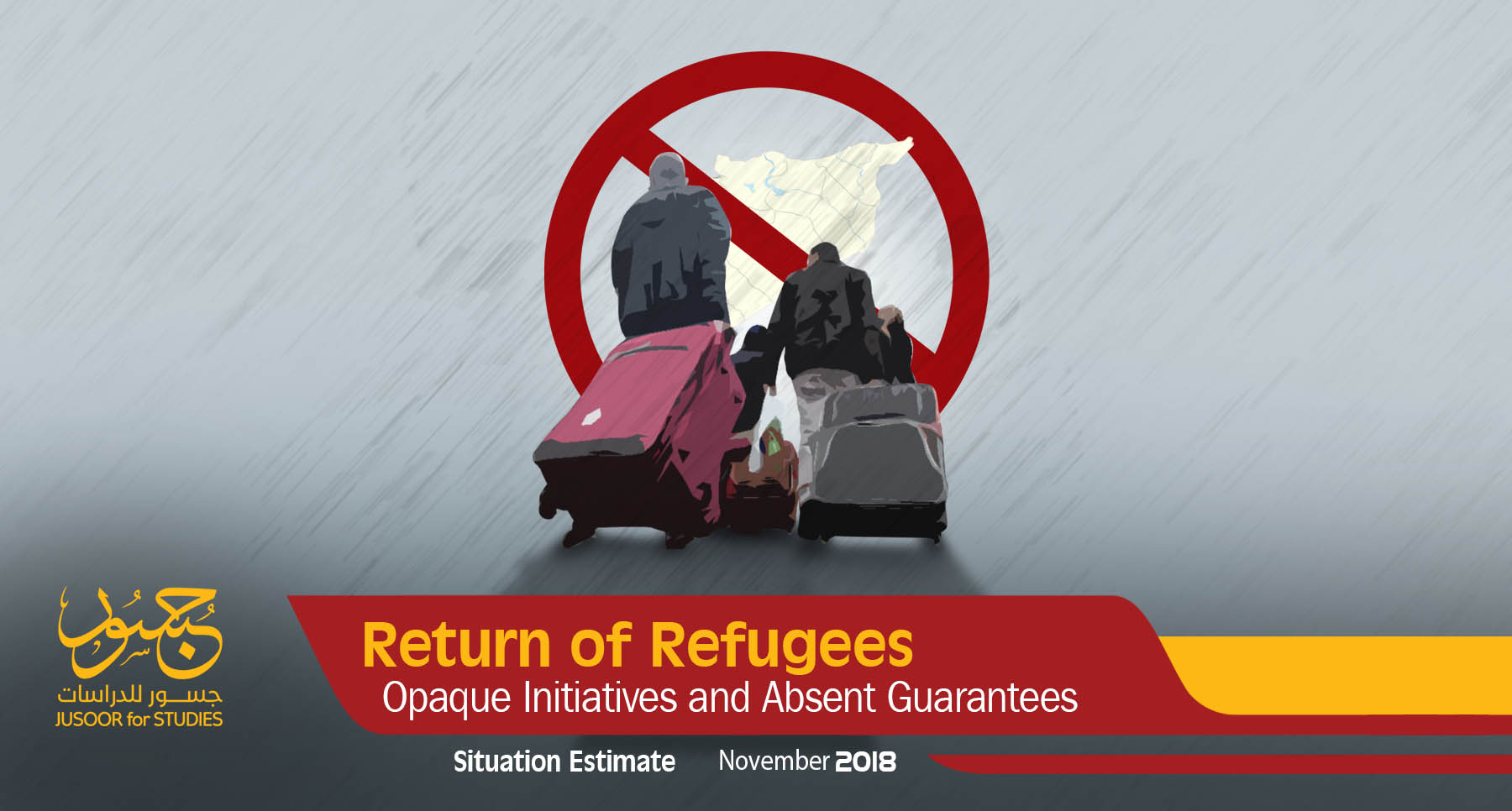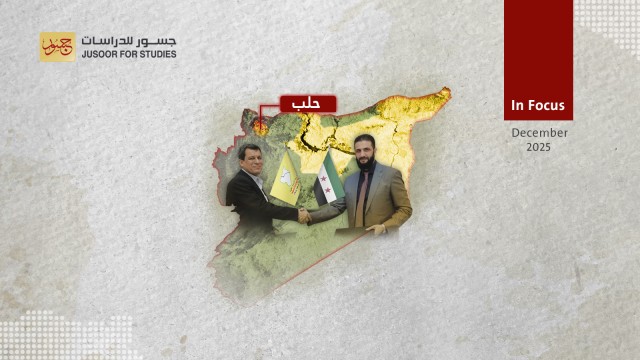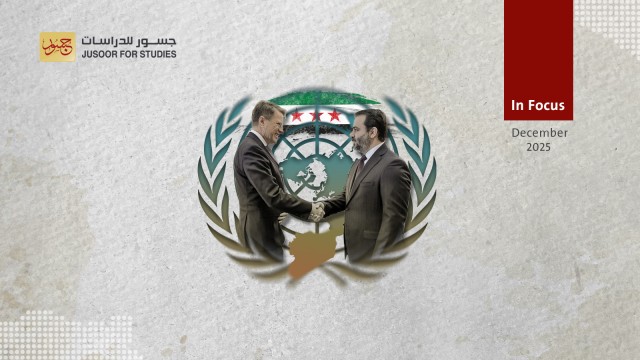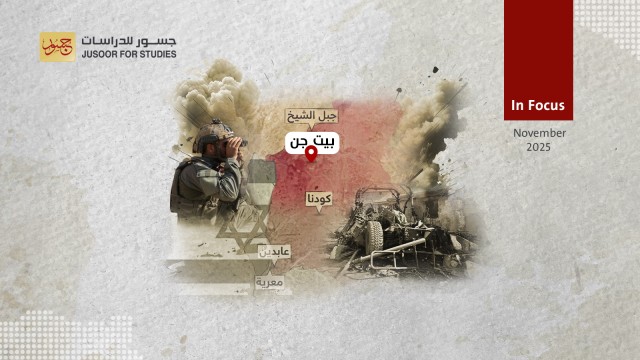Return of Refugees Opaque Initiatives and Absent Guarantee
Font Size
Preface
This summer witnessed dramatic field developments as the regime and its allied foreign forces were able to take control over the Syrian south shortly after taking control of Damascus countryside and the Damascus neighborhoods that were outside regime control.
These developments resulted in the regime’s allies proposing initiatives to return refugees to Syria. Hezbollah’s initiative was the first in this context, followed by the Russian initiative, then the Lebanese Public Security Directorate initiative.
Despite the fact that around five months have passed since the regime’s allies launched this new approach, it has so far achieved only limited results on the Lebanese level alone, while the return of refugees from any other country of asylum have not been recorded within the framework of these initiatives.
Russian marketing efforts have also failed to achieve any significant success in obtaining support from the international community to back these initiatives. The United Nations High Commissioner for Refugees (UNHCR) said that Syria is not yet sufficiently safe for the return of refugees and that it would play no role in organizing repatriation operations at the present time. Other active countries held the same approach.
These initiatives are full of doubts and concerns, starting with how to fulfill the “voluntary return” clause, the guarantees given to returnees, the extent of safety they will enjoy, and ending with how refugees will be returned, to which areas and the selective conditions imposed for screening refugees.
The legal and political responsibility related to these fears is not confined to the regime and its allies alone, but extend beyond them to other parties. Most of parties currently reject these initiatives, but have actively participated in recent years in creating an atmosphere for such initiatives to take place, thereby forcing Syrians to “return voluntarily” to the regime prison without any guarantees.
This report seeks to analyze the “refugee return” policies within its humanitarian and political contexts to reach the optimal form that achieves the return of all refugees, and not just some refugees in Lebanon.
First: The Most Prominent Initiatives
In the past five months, several initiatives have been proposed to legalize the return of Syrian refugees to their country. These initiatives came from key regime supporters, namely; Russia, Hezbollah/Iran and the Lebanese Public Security Directorate, which is managed, within the Lebanese distribution of power, by the pro-Syrian regime current.
1. Russian Initiative
Russia launched its initiative to return refugees in July 2018. On July 18, the Russian Ministry of Defense announced the establishment of a special center in Syria to receive, distribute and shelter internally displaced persons (IDPs) and Syrian refugees. The Ministry said that the center’s mission is to monitor the return of all IDPs and Syrian refugees from foreign countries to their permanent places of residence and to organize the arrival of humanitarian aid, basic necessities, building materials and essential material needs, including foreign aid to Syria. The center is also tasked with delivering this aid to the population, helping the Syrian authorities revive the health-care system and other public services, and to resolve other issues related to assisting the return of refugees and ensuring that their basic needs are met.
The Ministry said that welcoming centers were set up to receive 336,500 refugees in Syrian territory, 73,600 in Damascus Countryside Province, 134,350 in Aleppo Province, 64,000 in Homs Province, 10,600 in Hama Province, 45,000 in Deir ez-Zor and 8,950 in Eastern Qalamoun.
These figures are part of the Russian propaganda accompanying the initiative; however, the announcement about these “mega centers” did not include any details about their location or reports to show what preparations have finished.
At the end of July, the Russian Envoy to Syria Alexander Lavrentiev toured Damascus, Amman and Beirut to promote the Russian initiative. After the visit, the Syrian Council of Ministers established a “Coordinating Body for the Return of Migrants Abroad”.
2. The Turkish Initiative
Turkish officials have consistently stressed, especially during the election period, the need for the return of Syrian refugees to their country and that they are working to provide a suitable environment for their return.
However, the Turkish initiative for the return of refugees did not take a public form as in the case of other initiatives. The initiative is proceeding quietly without any announcements about its beginning or the form of implementation. It is believed that this initiative actually began after the end of the Euphrates Shield Operation in March 2017, and continues to this day. According to the Turkish Foreign Minister’s statement on November 25, the number of Syrians who have returned to northern Syria since the end of the Euphrates Shield has so far reached 260,000 refugees.
By following the Turkish procedures, it is possible to identify the features of the initiative in three aspects:
• Provide relative security in the Euphrates Shield and Olive Branch areas whether through political agreements with Russia, which protected these areas from any aerial attacks or bombardments by the regime or the foreign forces supporting it, or by providing an acceptable level of security in the area. The level of security has declined recently, which may be the justification behind Turkey launching the anti-corruption security campaign, which began on November 18, 2018.
• Rehabilitation and development of infrastructure, Turkey has invested heavily in hospitals, schools, mosques, parks and roads, and two Turkish universities have opened branches in the Syrian north. These development investments have helped to restore normal life in the Euphrates Shield areas specifically, and some of the services currently available have surpassed those that were available in these areas before 2011.
• Provide incentives to refugees who wish to leave the camps whether to reside elsewhere inside Turkey or return to Syria. These incentives include an amount of approximately 300 US Dollars (USD) per person. These financial incentives have helped encourage many to use the money to return to Syria.
3. Hezbollah Initiative
At the end of June 2018, Hezbollah Secretary-General Hassan Nasrallah announced in a speech the formation of a committee to assist and facilitate the return of Syrian refugees. He said that the Party took this initiative as a result of the slow handling of the file in Lebanon, and based on the Party's good relationship with the Syrian state and considering its role within the situation in Lebanon. He said that the Party will communicate with Syrian refugees to determine the mechanism for submitting applications to return as many Syrian refugees who want to return voluntarily. The Party will continue this assistance until this file is resolved politically between Lebanon and Syria.
On July 4, 2018, the Party announced the launch of a program for the return of refugees wishing to return to Syria. The Party opened centers to receive refugees’ applications in Baalbek, al-Hermel, al-Laboua, Bednayel, Beirut’s Southern Suburb, Nabatieh, Tyre, Bint Jbeil and al-Adaisa.
According to the official in charge of the “Displaced Syrians file in Hezbollah”, former MP, Nawar al-Saheli, “The committee of displaced Syrians’ file in Hezbollah” will receive refugees in the centers and ask them to fill out a form, and the forms are collected and sent to the “concerned authorities” in Syria. After that the centers will contact the Lebanese Public Security Directorate and when there is an adequate number of refugees who can be returned, their return to Syria will be arranged. Al-Saheli described that the aim of the initiative falls within the interest of the Lebanese people first and foremost, adding, “With our love for our Syrian brothers who consider themselves in their country, but it is better for them to return to their homeland to relieve Lebanon which is suffering from a lot of problems.”
On November 14, Mouin al-Murabi, the Lebanese Minister of Displaced Persons Affairs, announced that Lebanon received credible information that Syrian security services killed 20 refugees who had returned to Syria .Al-Murabi said that large families have been informed that they are not allowed to return to certain areas, meaning that they can return to Syria, but not to their original areas. These data are related to the regulations that have been put in place through the coordination between the Syrian and Lebanese security apparatuses which aims at screening refugees and the areas they are allowed or forbidden to return to. He added that the process is to complete the demographic cleansing by screening the refugees, and that the process is systematic, and not a simple detail, and many countries and institutions are involved in it .
Based on interviews conducted with some people who visited the “voluntary return” offices, they said they were treated to a security procedure during their visit and centers’ procedures instilled fear among refugees rather than encouraging them to return to Syria. Lebanese sources closely following the work of these offices indicate that the main purpose of the refugee reception offices is to frighten refugees and push them out of Lebanon, but not to Syria. According to these sources, the aim is to push refugees to gangs that smuggle people to Europe which work near these offices. The gang members prey on refugees after they leave the offices and have been exposed to threats and harsh security treatment.
4. The Initiative of the Lebanese Public Security Directorate
On August 6, 2018 the Lebanese Public Security Directorate announced it allocated centers to receive the applications of displaced persons on all Lebanese territory wishing to voluntarily return to their homeland. The announcement identified 18 centers in various Lebanese territories.
The announcement represented a legalization of a program started by the directorate in June to arrange the voluntary return of refugees in coordination with the Syrian security apparatuses.
The initiative came about a month after the launch of the Hezbollah initiative. A spokesman for the Party said they would continue to register refugees and that there was no connection between the two initiatives.
According to the Directorate, the number of people who returned to Syria from the beginning of July to the beginning of November was 87,670, of whom 7,670 returned through the Directorate’s initiative .
Second: Motives of Regime Allies
The regime’s allies seek to put forward programs to return refugees to Syria to achieve a number of objectives, most importantly:
1. Claim that the Syrian regime has won the war as the return of refugees presents the outside world with the impression that the situation has returned to what it was. The move aims to claim that the refugees have returned because the reason for them to seek refuge has gone, and the regime was not the cause of so many people’s displacement and seeking refuge. Such a claim gives direct political gains to the regime allies both internally and externally.
2. Using the return of refugees as a means to legitimize the political objectives of the regime’s allies and weaken the justifications of the international community in postponing granting the regime government political legitimacy, especially since the United States and its allies have repeatedly stressed that the return of refugees is a prerequisite for the Syrian government that they can deal with. The “Declaration of Principles of the Small Group for Syria”, on September13, 2018, clearly affirmed this clause.
3. Accelerating the possibility of proposing reconstruction issues as the regime’s allies cannot rebuild alone, and need about 400 billion USD from European countries and the other USA partners. Also, they cannot obtain this support without obtaining political legitimacy for the de facto regime imposed by the Russians in Damascus.
4. Fulfill the wish of refugee hosting and funding countries for their care programs as the return of refugees will relieve these countries from economic, political and social burdens. Resisting refugee return initiatives is causing internal political crises in some countries as governments will appear as if they want to settle refugees in their countries which no government wants.
In the Lebanese case, the Russian initiative or the Hezbollah initiative fulfills the stated desire of most of the political actors in the state. The skeptics of this initiative or those who refuse to deal with the Syrian regime do not have much space to stand against these initiatives because of the sensitivity of the issue of Syrian asylum internally.
The head of the National Center for Russian Defense, General Mikhail Mezintsev played on this issue when he said that 200,000 refugees in Europe would return to Syria as part of the Russian initiative, and that Europe spent more than 140 billion USD on its immigration policies. According to Mezintseve, “They did it to deliberately push Syrian citizens to give up the idea of returning home” .
Third: Actors’ Responsibilities
The return of refugees in its current form, which is ongoing at present, entails no guarantees from any party and without the participation of the United Nations. This return is the result of a series of policies and stands of many actors, all of whom bear direct and indirect responsibility for the violations that may occur or have occurred against the returning refugees. They also bear varying degrees of responsibility for the suffering of the refugees during their refuge, and for originally causing their refuge.
These actors can be grouped into four domains, as follows:
1. The Regime
The Syrian regime has full legal and political responsibility for the safety of refugees and to ensure their return to their place of origin. The regime also bears full responsibility in most of the cases for the reasons that led to refugees’ migration. Therefore, the regime is responsible for all the violations that they been exposed to from the very first moment to considering migration as an option to escape violations and crimes that have taken place or that were likely to take place.
The regime refused to provide any guarantees to protect the returnees, considering that the its allies’ military superiority and the absence of international pressure on the regime relieves it from this burden.
The regime does not allow international organizations to move freely and meet returning refugees to ensure their safety, nor does it allow local organizations and activists to monitor any violations that returnees may face. The regime has not made any structural changes in its security, military and political institutions. In other words, the authorities and persons responsible for the displacement of about half of the population of Syria are still the decision-makers in Damascus and they are supervising the refugee return programs.
2. The Regime Allies
The regime allies have direct and indirect responsibility for securing all the refugee return operations to Syria, especially since these countries (or actors) have provided the only initiatives currently underway for repatriating refugees, either through the Russian initiative or through the Hezbollah/Iran initiative.
These responsibilities can be summarized as follows:
• Purposeful absence of guarantees: The initiatives presented do not provide any real guarantees for the safety of the returning refugees. The initiatives do not provide for the possibility of the refugees’ returning to their actual areas and not just to Syria; although, the actors proposing these initiatives are in fact the only ones capable of providing such guarantees.
• Absence of subsequent protection: Even with the voluntary return of refugees without guarantees, the regime allies have not provided protection for returnees inside Syria. The allies have the potential to pressure the regime, on the one hand, and can directly intervene to provide protection, on the other hand.
• Purposeful absence of specialized international organizations: These initiatives have neutralized all relevant international institutions, in particular UNHCR which is concerned with registering refugees, following up their cases during their asylum and supervising their safe return. Indeed, the initiatives were accompanied by an unprecedented escalation by the Lebanese Foreign Ministry (run by another regime ally) against UNHCR where the organization was accused of working to settle the refugees in Lebanon simply because UNHCR demanded minimum guarantees for the refugees’ safety.
• Responsibility for violations during the period of asylum: Regime allies in Lebanon are very active within the Lebanese state and therefore bear direct and indirect responsibility for the violations committed against Syrian refugees in Lebanon since 2011 until now. The role of these violations will be reviewed in the “host countries” section.
• Direct responsibility for acts of violence: Regime allies have participated in indiscriminate bombing and direct killings, and committed hundreds of massacres in previous years, making them a direct and main cause of Syrian displacement and refuge.
3. Host Countries
The situation of Syrian refugees in host countries varied considerably due to several factors. The most important factor is the political apparatuses’ stand towards the regime, the country’s economic capabilities and the demographic situation in the host societies.
The situation of Syrian refugees in Lebanon represented the worst among all the countries of asylum where the Lebanese government, under the pressure from the regime’s allies, refused to open official refugee camps for Syrian refugees like other countries of asylum. Hence, it denied refugees the possibility of accessing the services of international organizations and limited the ability of local humanitarian organizations to provide basic needs requirements.
Syrian refugees in Lebanon were exposed to various forms of racial discrimination in parallel with public hate speech. Senior government politicians, various media outlets, municipalities and business institutions all contributed to promoting and circulating the hate speech. Furthermore, Syrians in Lebanon have been subjected to security campaigns by the Lebanese army, security forces and unofficial militias under the pretext of combating terrorism and other pretexts.
All these factors have contributed to pushing the refugees in Lebanon to search for any viable options for life outside Lebanon, even if this puts their lives at risk at the mercy of the regime.
The remaining host countries have a mutual responsibility with the international community due to their insistence on only accepting documents issued by the Syrian regime, restricting Syrians freedom of movement and other restrictions. All these restrictions have prevented Syrians from practicing normal life, leading them to seriously consider “voluntary return” to the regime. On November 15, 2018, the Higher Education Council in Jordan took an advanced step in this regard when it adopted the security card for Syrian students instead of the passport.
4. The International Community
The regime allies have assumed the refugee return initiatives and consider this return, in part, as a mode of targeting Western plans to keep the refugee card as a weapon to use against the regime’s allies. The Lebanese government targets the UN organizations in parallel with the campaigns to “voluntary return” refugees. Despite these, the international community, represented in various states and organizations, are directly and indirectly responsible for the violations that have been committed against refugees and the violations that might be committed against those who return.
The responsibility of the International Community can be summarized as follows:
• Lack of attention to the Syrian human rights file in general and to the violations that have been committed against refugees in particular, due to many considerations. After the issue of Syrian asylum has become an internal affair in many countries of the world, the focus on violations against refugee rights in neighboring host countries especially Lebanon, could result in a discussion about the responsibilities of the rest of the world towards Syrian refugees. The regime allies realized this issue accurately, and are working to invest in it to the maximum extent possible.
• Disrupting the political process since the issue of the return of refugees is directly linked to the comprehensive political solution, which is supposed to provide all Syrians with guarantees to live safely in Syria. It also necessarily includes changes in the political and security structure of the regime and restructuring the judiciary and police forces and other necessary standards.
However, the political solution process has been almost completely halted for around two years. The international community has not provided any effective political initiatives in this regard, giving the regime’s allies full freedom to move forward and implement the initiatives, in almost complete absence of other actors.
• Lack of funding as since 2014, donor countries have gradually been working to mitigate their commitments to refugee care programs on the one hand, and not pay its remaining commitments on the other (see Figure 1). The donor countries themselves and the host countries have also severely curtailed the work of Syrian humanitarian institutions that collect aid for Syrians. This is reflected in the poor services provided to the refugees, the continuous reduction in the allocations they receive which pushes them to accept bad options such as returning to regime controlled areas to escape a bitter reality that does not provide them with the decent life they searched for.
Figure 1
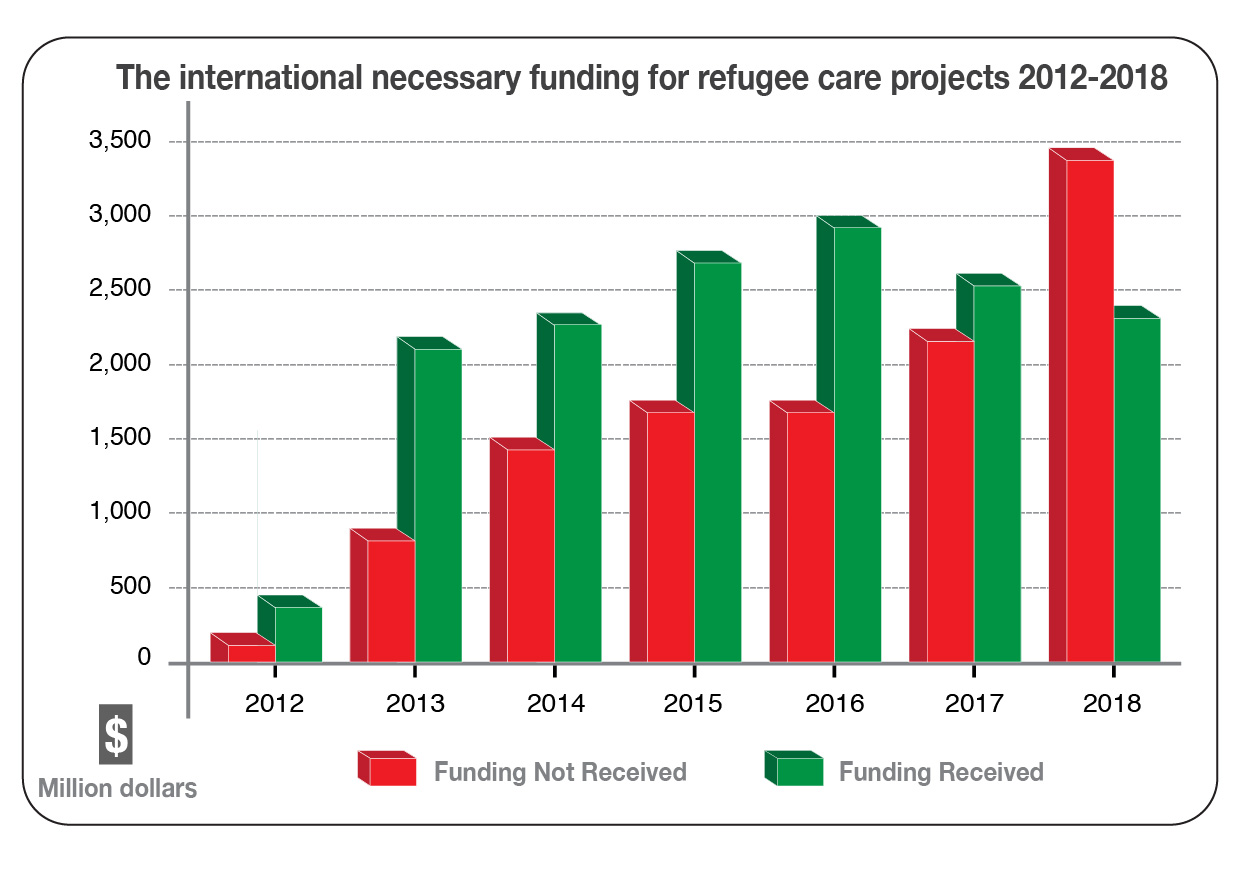
Conclusion
The return of refugees and IDPs to their homes is certainly a legitimate objective and should be the focus of all political projects related to Syria. The presence of 6 million refugees outside Syria, and almost the same number of IDPs within Syria, constitutes a real obstacle to stability and the return of normal life.
But talking about the return of refugees in abstract and without consideration for the reasons that led to refugees to flee their homes in the first place, is simplifying and flattening a human tragedy that is the largest in the world since the Second World War. Most of the refugees fled their homes due to the brutal massacres committed by the Shabiha, security forces, army and pro-regime foreign militias. They fled from the systematic use of indiscriminate weapons of destruction, such as explosive barrels, and the use of internationally banned weapons, such as chemical and cluster weapons. They fled the crimes of arrest and murder under torture, systematic rape and many other crimes documented over the past eight years.
The demand for the return of the refugees to the rule of the same regime they fled from, without any changes to the regime and without assurances from the parties that allowed it to remain, represents an attempt to impose a fait accompli, with the force of explosive barrels, Russian aircraft missiles and pro-regime militias’ knives.
Despite what seems like a “formalistic voluntary" return of refugees from Lebanon, the circumstances under which Syrians have lived during the period of their refuge represents a force form aimed at pushing them to return to the prison of the regime and deny the optional nature of the return. These refugees did not have the minimum conditions of a decent life during their time of refuge and all forms of institutional and societal oppression have been imposed on them to the point that they consider returning to their homes (or ruins) as a possible option.
The initiatives to return refugees to Syria without a comprehensive political solution that includes actual changes in the structure of the security regime and without international and local guarantees represent a push for Syrians to return to the prison of the regime. It also consecrates the crimes and violations that were committed the first time and establishes for the grounds for further violations.
In addition, the initiatives that avoid dealing with the legitimate rights of refugees to return to their land of origin, compensate them for damages to their properties, and discriminate between refugees on a doctrinal basis (preventing the inhabitants of Qalamoun from returning to their homes despite the area being safe) represents an escape from a temporary crisis towards a future explosion.
Despite the partial success of regime allies’ initiatives so far in Lebanon due to several factors specifically related to this country, they still have not achieved any success in the remaining the countries of asylum which host 84% of Syrian refugees.
The Turkish initiative is achieving far higher results than those of the regime allies because of the relatively high safety situation in the Euphrates Shield and Afrin areas, both in terms of the absence of aerial and artillery bombardments, and in terms of the regime’s inability to arrest returnees.
The failure of regime supporters to provide real guarantees and push for a real political solution will not solve the problem of Syrian asylum, and they will only suffice with achieving some imaginary victories for some extremist politicians in Lebanon only.
The return of refugees and IDPs to their homes is certainly a legitimate objective and should be the focus of all political projects related to Syria. The presence of 6 million refugees outside Syria, and almost the same number of IDPs within Syria, constitutes a real obstacle to stability and the return of normal life.
But talking about the return of refugees in abstract and without consideration for the reasons that led to refugees to flee their homes in the first place, is simplifying and flattening a human tragedy that is the largest in the world since the Second World War. Most of the refugees fled their homes due to the brutal massacres committed by the Shabiha, security forces, army and pro-regime foreign militias. They fled from the systematic use of indiscriminate weapons of destruction, such as explosive barrels, and the use of internationally banned weapons, such as chemical and cluster weapons. They fled the crimes of arrest and murder under torture, systematic rape and many other crimes documented over the past eight years.
The demand for the return of the refugees to the rule of the same regime they fled from, without any changes to the regime and without assurances from the parties that allowed it to remain, represents an attempt to impose a fait accompli, with the force of explosive barrels, Russian aircraft missiles and pro-regime militias’ knives.
Despite what seems like a “formalistic voluntary" return of refugees from Lebanon, the circumstances under which Syrians have lived during the period of their refuge represents a force form aimed at pushing them to return to the prison of the regime and deny the optional nature of the return. These refugees did not have the minimum conditions of a decent life during their time of refuge and all forms of institutional and societal oppression have been imposed on them to the point that they consider returning to their homes (or ruins) as a possible option.
The initiatives to return refugees to Syria without a comprehensive political solution that includes actual changes in the structure of the security regime and without international and local guarantees represent a push for Syrians to return to the prison of the regime. It also consecrates the crimes and violations that were committed the first time and establishes for the grounds for further violations.
In addition, the initiatives that avoid dealing with the legitimate rights of refugees to return to their land of origin, compensate them for damages to their properties, and discriminate between refugees on a doctrinal basis (preventing the inhabitants of Qalamoun from returning to their homes despite the area being safe) represents an escape from a temporary crisis towards a future explosion.
Despite the partial success of regime allies’ initiatives so far in Lebanon due to several factors specifically related to this country, they still have not achieved any success in the remaining the countries of asylum which host 84% of Syrian refugees.
The Turkish initiative is achieving far higher results than those of the regime allies because of the relatively high safety situation in the Euphrates Shield and Afrin areas, both in terms of the absence of aerial and artillery bombardments, and in terms of the regime’s inability to arrest returnees.
The failure of regime supporters to provide real guarantees and push for a real political solution will not solve the problem of Syrian asylum, and they will only suffice with achieving some imaginary victories for some extremist politicians in Lebanon only.
Footnotes:
1- Russia Establishes Centers for Receiving, Distribution and sheltering of Refugees, Russia Today, 18/07/2018
2- Important statement from Minister of Foreign Affairs Cavusoglu, TRT Arabic, 25/11/2018
3- Mr. Nasrallah: For the most extensive governmental representation and we are in front of a huge victory south of Syria, Al-Manar Channel, 30/06/2018
4- Sputntk Reveals Hezbollah Mechanism to return Syrian Refugees to their Country, Sputnik, 04/07/2018
5- Al-Murabi: Syrian Regime has to Stop Criminality, Alhayat Newspaper, 14/11/2018
6- The World Throws Syrian Refugees under the Assad Cleansing Guillotine, Almodon, 16/11/2018
7- Modification of work hours in reception centers for refugees wishing to voluntarily return to their homeland, Lebanese Public Security Directorate, 06/08/2018
8- Pressure to return builds on Syrian refugees in Lebanon, IRIN, 20/8/2018
9- Statistics for the number of returned refugees July 2018 to date, Lebanese Public Security Directorate, 02/11/2018
10- Long reach of U.S. sanctions hits Syria reconstruction, Reuters, 2/9/2018
11- Russian Ministry of Defense: 200,000 Refugees might Return to Syria in the Near Future, Sputnik, 24/07/2018
12- Russian Ministry of Defense: Europe Spent 140 Billion USD on Syrian Refugees, Russia Today, 19/10/2018
2- Important statement from Minister of Foreign Affairs Cavusoglu, TRT Arabic, 25/11/2018
3- Mr. Nasrallah: For the most extensive governmental representation and we are in front of a huge victory south of Syria, Al-Manar Channel, 30/06/2018
4- Sputntk Reveals Hezbollah Mechanism to return Syrian Refugees to their Country, Sputnik, 04/07/2018
5- Al-Murabi: Syrian Regime has to Stop Criminality, Alhayat Newspaper, 14/11/2018
6- The World Throws Syrian Refugees under the Assad Cleansing Guillotine, Almodon, 16/11/2018
7- Modification of work hours in reception centers for refugees wishing to voluntarily return to their homeland, Lebanese Public Security Directorate, 06/08/2018
8- Pressure to return builds on Syrian refugees in Lebanon, IRIN, 20/8/2018
9- Statistics for the number of returned refugees July 2018 to date, Lebanese Public Security Directorate, 02/11/2018
10- Long reach of U.S. sanctions hits Syria reconstruction, Reuters, 2/9/2018
11- Russian Ministry of Defense: 200,000 Refugees might Return to Syria in the Near Future, Sputnik, 24/07/2018
12- Russian Ministry of Defense: Europe Spent 140 Billion USD on Syrian Refugees, Russia Today, 19/10/2018

